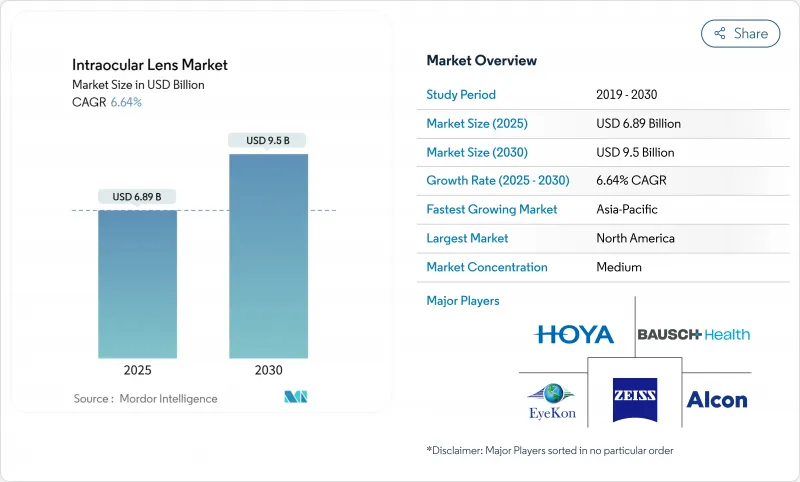
|
市場調査レポート
商品コード
1851560
眼内レンズ:市場シェア分析、産業動向、統計、成長予測(2025年~2030年)Intraocular Lens - Market Share Analysis, Industry Trends & Statistics, Growth Forecasts (2025 - 2030) |
||||||
カスタマイズ可能
適宜更新あり
|
|||||||
| 眼内レンズ:市場シェア分析、産業動向、統計、成長予測(2025年~2030年) |
|
出版日: 2025年07月01日
発行: Mordor Intelligence
ページ情報: 英文 110 Pages
納期: 2~3営業日
|
概要
眼内レンズ市場は、2025年に68億9,000万米ドルと評価され、CAGR 6.64%で成長し、2030年には95億米ドルに達すると予測されています。

プレミアムレンズの革新、高齢者の増加、外来手術モデルへのシフトがこの拡大を支えています。65歳以上の人口の増加は白内障の安定した症例流入をもたらし、老眼矯正と光調整可能な設計は、外科医がメガネの自立に対するライフスタイルの期待の高まりに対応できるようにします。シリコーンや次世代疎水性アクリル素材は炎症性事象を軽減し、外科医がより自信を持ってプレミアムアップグレードを検討できるよう促します。アジア太平洋の医療観光回廊は先進レンズへのアクセスを広げ、オフィスベースのスイートはプロバイダーの経済性を改善し、新たな手術能力を生み出します。競争は激化の一途をたどっていますが、これは、視覚の質を高めたり、視力障害を軽減したりする製品サイクルのたびに、外科医の嗜好がすぐにリセットされるためです。
世界の眼内レンズ市場の動向と洞察
高齢化に伴う世界的な白内障手術の増加
白内障の罹患率は人口の長寿化に比例します。80歳を超えると70%の確率で水晶体混濁を発症し、多くの人がデジタルへの継続的な関与とその後の人生の雇用のために高品質の視力を期待しています。外来手術センターではすでに白内障が最大の症例数となっており、2024年にはASCの症例数の19%を占める。アジア太平洋地域では、人口動態の高齢化がクリニックの増築を上回っているため、医療提供者による高スループットモデルの採用が増加しています。
プレミアム/老視矯正眼内レンズの採用急増
保険償還の格差にもかかわらず、プレミアムの普及率は2019年の15.5%から2021年には18.5%に上昇。光調整可能な光学系により、術後の度数調整が可能になり、残存屈折異常のリスクが縮小されます。アルコンは、PanOptixとVivityファミリーの強みでこのセグメントの60%以上を占めています。Tecnis Eyhanceのような強化された単焦点設計は、回折リングの光学的問題なしに奥行きを拡大し、ハローやグレアを警戒する患者への適用範囲を広げています。
プレミアム眼内レンズの高額な自己負担額と不均等な払い戻し
CMSはニューテクノロジーIOLのコードを記載していないため、患者はしばしば片眼あたり1,500~3,000米ドルを支払う。金銭的な負担には、アベロメトリー診断とフォローアップ調整が含まれるため、価格に敏感な候補者は敬遠します。海外出張は請求額を下げることができるが、品質保証は施設によって異なります。
セグメント分析
2024年の眼内レンズ市場シェアは63.25%で、単焦点レンズが数量のリーダーを維持。三焦点、トーリック、EDOF、収容設計にまたがるプレミアムカテゴリーはCAGR 7.45%を記録し、ベースラインの白内障の成長を上回る。需要は、矯正されていない近方視力を優先する患者や、白内障管理の一環として屈折矯正の成果を促進する外科医から生じています。PanOptixのような多焦点眼内レンズは、初期の遠近両用眼内レンズと比べ、高い独立性とハローの少なさを実現しています。トーリックモノフォーカルは角膜円柱を4Dまで矯正し、乱視が1Dを超える眼では日常的に使用されるようになりました。Tecnis SymfonyのようなEDOF光学系は、光副作用の軽減と引き換えに近用視力を多少低下させ、回折リングに懐疑的な患者にフィットします。Juveneを含むアコモデーションのプロトタイプは、生理的な焦点変化を再現することを目指し、3.5Dを超える振幅をターゲットとしています。
手術センターでは、老眼矯正レンズとフェムトセカンド補助カプセル切開術をバンドルして遠心力を強化し、トポグラファーがトーリック軸のアライメントについて術前計画を改良しています。臨床医によると、屈折矯正手術後の患者は、光調整技術によって残存誤差を微調整できるためプレミアムソリューションを好むことが多く、プレミアム層は1術式あたりの収益を拡大し、診療報酬の逆風を補い、高度な診断への投資を促します。
疎水性アクリルは、折り畳みやすさ、被膜の生体適合性、耐光性処方により、眼内レンズ市場規模のほぼ半分を支え続けています。Clareonのような表面改質アクリルは、透明性を高めるために含水率を高めているが、石灰化リスクは低いです。シリコーンのCAGRは7.23%で、ルネッサンスの兆しを見せています。高純度グレードは炎症性細胞の付着を最小限に抑え、ぶどう膜炎の目に魅力的なレンズとなっています。新しいシリコーン光学系は、UVカットの発色団を組み込んでおり、インプラント後のフェムト秒による度数調整も可能です。親水性アクリルは現在、装用数の29%を占めており、糖尿病硝子体環境でも透明度を維持する架橋ポリマーと抗カルシウムコーティングによって回復しています。PMMAの使用は、剛性安定性の恩恵を受ける外傷症例を除いて減少しています。
材料の調査は、エッジデザインのマイクロテクスチャリングによる後嚢混濁の低減と、被膜線維症が視神経を固定した後に消失する生体吸収性ハプティクスの探求に重点を置いています。パンデミックによる混乱で疎水性アクリル鎖の依存リスクが明らかになったため、サプライヤーは原料モノマーの二重調達を強調しています。
地域分析
2024年の眼内レンズ市場は北米が42.23%の売上でリードしました。メディケアがベースライン白内障手術をカバーしており、患者はアップグレードを自己負担できるためです。米国では保険料の普及率が22%を超え、眼科医院はRLE候補者を集めるために大々的な広告を展開しています。この地域の眼内レンズ市場規模は、オフィスベースの手術室と調整可能なレンズプラットフォームの急速な普及に支えられ、CAGR 5.8%で2030年までに40億米ドルを超えると予測されています。
アジア太平洋地域は、人口動態の高齢化、中間層の消費力拡大、医療観光クラスターの繁栄により、CAGR最速の7.45%を記録しています。タイとシンガポールは、眼内レンズのプレミアム手術を3日間の回復滞在付きでパッケージ化し、平均販売価格を引き上げるインバウンド量を引き寄せています。中国は白内障手術のキャパシティを拡大し続けているが、プレミアム眼内レンズの導入率はまだ10%未満であり、所得と診療報酬の水準が上昇すれば、成長の余地が大きくなることを示しています。インドの大量生産拠点は、効率性とモジュール式価格設定を組み合わせたアラビンド・モデルを再現しており、プレミアム導入を都市部の消費者にも手の届くものにしています。
欧州では、償還制度は成熟しているが、持続可能性に関する規範は強固です。規制当局がプラスチック削減を推奨しているため、レンズメーカーはバイオ由来のカートリッジポリマーを試しています。ドイツとスペインは20%近いプレミアム普及率を報告しているが、英国は国民保健サービスの予算制約の中で保守的です。2025年にCEマークを取得したClareon Vivityなどが発売され、外科医にとって老眼矯正の選択肢が広がります。
中東とアフリカは、官民パートナーシップにより湾岸諸国と北アフリカに専門眼科病院が建設され、低水準から拡大します。富裕層の患者は、高級な手術を受けるために欧州やアジアに向かうことが多いが、ドバイやリヤドに新設されたセンターは、国外への流れを逆転させることを目指しています。南米は北米からの価格裁定を求める患者の恩恵を受ける。ブラジルの民間保険会社は現在、特定のEDOFレンズを払い戻し、地域の需要を引き上げています。
その他の特典:
- エクセル形式の市場予測(ME)シート
- 3ヶ月間のアナリストサポート
よくあるご質問
目次
第1章 イントロダクション
- 調査の前提条件と市場の定義
- 調査範囲
第2章 調査手法
第3章 エグゼクティブサマリー
第4章 市場情勢
- 市場概要
- 市場促進要因
- 高齢化に伴う白内障手術の世界的増加
- プレミアム/老眼矯正眼内レンズの採用急増
- 急速な製品サイクル:調光レンズとAI設計レンズ
- 40~60歳における屈折矯正(RLE)の成長
- 医療ツーリズムのハブが手続きコストを下げる
- 手術室のボトルネックを緩和するプレローディング型単回使用眼内レンズシステム
- 市場抑制要因
- プレミアム眼内レンズの高額な自己負担額と償還のばらつき
- 術後の視力障害への懸念が外科医の導入を制限している
- 特殊疎水性アクリルのサプライチェーン依存度
- レンズ供給における使い捨てプラスチックへの持続可能性への圧力
- 規制情勢
- テクノロジーの展望
- ポーターのファイブフォース分析
- 新規参入業者の脅威
- 買い手の交渉力/消費者
- 供給企業の交渉力
- 代替品の脅威
- 競争企業間の敵対関係
第5章 市場規模と成長予測
- 製品タイプ別
- 単焦点眼内レンズ
- プレミアムIOL
- 多焦点
- トーリック
- 調節機能付き
- Phakic眼内レンズ(PIOL)
- その他
- 材料別
- 疎水性アクリル
- 親水性アクリル
- シリコーン
- ポリメチルメタクリレート(PMMA)
- その他
- エンドユーザー別
- 病院
- 外来手術センター
- 眼科クリニック
- その他
- 用途別
- 白内障
- 老眼
- 角膜疾患
- その他
- 地域別
- 北米
- 米国
- カナダ
- メキシコ
- 欧州
- ドイツ
- 英国
- フランス
- イタリア
- スペイン
- その他欧州地域
- アジア太平洋地域
- 中国
- 日本
- インド
- オーストラリア
- 韓国
- その他アジア太平洋地域
- 中東・アフリカ
- GCC
- 南アフリカ
- その他中東・アフリカ地域
- 南米
- ブラジル
- アルゼンチン
- その他南米
- 北米
第6章 競合情勢
- 市場集中度
- 市場シェア分析
- 企業プロファイル
- Alcon Inc.
- Johnson & Johnson Vision
- Bausch+Lomb Corp.
- Carl Zeiss Meditec AG
- Hoya Corp.
- Staar Surgical Co.
- Rayner Group
- HumanOptics Holding AG
- Lenstec Inc.
- PhysIOL(BVI)
- Ophtec BV
- SAV-IOL SA
- Aurolab
- Medicontur Medical Engineering
- Santen Pharmaceutical Co.
- Biotech Healthcare
- Eyekon Medical
- Rodenstock Group
- Visioncare Ophthalmic Technologies
- Hanita Lenses

